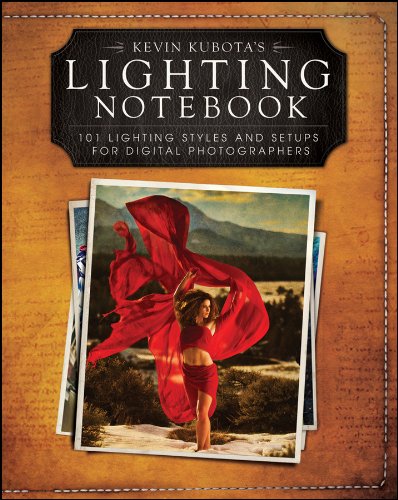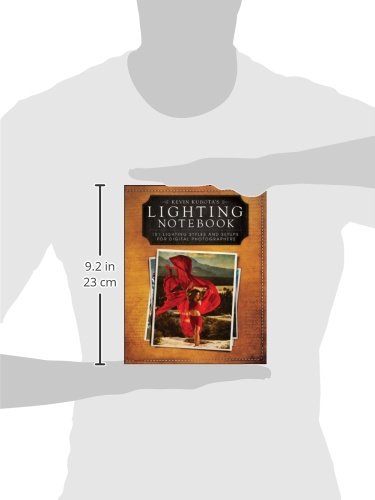معلومات عنا
دعم العملاء
احصل على التطبيق

قم بتوجيه الكاميرا لتنزيل التطبيق
حقوق الطبع والنشر © 2024 Desertcart Holdings Limited



Full description not available
S**F
A decent book with some interesting ideas
I bought this book twice - first time as a gift for a friend of mine who helped me with photography when I was starting and recently again to show some of my colleagues from photo business how to make a decent studio setups with little effort.I like this book as it is very descriptive and has a lot of info about used equipment for specific shoots. I'm however a bit confused about its particular targeted crowd - new photogs will probably have problems finding exactly same equipment to use (SB-800 anyone?) and older, more experience photogs will already have their own stuff, probably of different brand and/or type and they generally know most of these setups. I took one star for that one - I know it is an older edition, but still.Still, there are some really cool samples and ideas within this book so I guess $20 isn't much for it, especially since a decent lens is most likely 100x more expensive anyway...I removed a second star due to annoying and really cheap way that Mr. Kubota promotes his product throughout the whole book. Pretty much ANY photo he took he sent through Photoshop and used some of his filters (which he, of course, would be more than happy to sell to you), pretty much telling you how you can get a good result without software. Boulderdash.This shameless self-promotion is pitiful and totally misleading. While I think that Mr. Kubota has some really cool photos in his portfolio and is certainly a man with good ideas, this books tarnishes that reputation somewhat.After all is said and done, my recommendation is that you look for a different book with similar material. This one is somewhat old and although it has some decent setups and ideas you can find similar material presented elsewhere and with less shameless self-promotion.
D**T
Kevin Kubotas Lighting Notebook
Kevin Kubota has taken his years in the trenchs has a portrait and wedding photographer and put those experiences between the covers of a well thought out book. His time spent teaching workshops is represented as well. The book is thoughtfully laid out, and easy to follow. Key terms are clearly defined and expanded upon so the guide will be useful for newbies and for experienced photog's looking to expand their palette. I have read lighting guides written by just about everyone that has issued one, and so far Kevin Kubota's is the most accessible, in that he approaches the set ups from the perspective of a working portraitist.(Not a photo-rock star shooting a complicated tableau) It also helps that Kevin Kubota's approachable, personality is represented in the writing. It is written with humor trough out. (helpful in what can be a dry subject)In addition to the notebook of lighting set ups, there is a chapter on Essential Lighting skills, that generously takes photographers just starting out through the concept of photographic lighting, and gives real world explanations.The chapter on equipment is detailed and offers low cost alternatives to help defray what can be an expensive range of gear for those just starting to build their studio.The post production chapter is clearly written with helpful screen shots so you can actually find the "curves adjustment" button in lightroom or whatever enigmatic fiddly thing that needs to be tweaked.I recommend this guide highly.
L**O
misleading
Unfortunately, the book seemed like a hard sell marketing tool to promote his photoshop and lightroom post processing actions. Yes, he does give lighting diagrams on how he lit the image. He would then show the image straight from the camera and then the same image after using one or more of his post processing tools. Sadly, some of the images straight from the camera look poorly lit, some even underexposed. And of course a better looking image is shown with matching description of which of his actions were used to achieve this.Now, what's wrong with that. It might give people the impression that you need to buy those actions to achieve better photos, when in reality, some of the images would have looked much better straight from the camera if he just lit them better via exposure, quality of light, and choice of white balance.For example: bride with a view on page 142-143...the exposure of the image straight from the camera was very dark, yet his final image after using his 3 of his post processing effects was much brighter and with a warmer color tone. Why didn't he light it correctly and use a warmer color balance so that the image straight out of the camera would have looked much better and closer to what he wanted to achieve? Is it because he couldn't figure out how to light it better in the first place? Or is it because he wants to convince people that they need to buy his post processing tools?So, if you are new to lighting and want to learn lighting I strongly suggest another book wherein they teach you to light so that you can get better images straight out of the camera without the need of having to buy post processing actions. Now, if this book also taught you how to create those actions he uses, then it may have been more useful but it doesn't.
N**0
An amazing ebook! The book is full of great information ...
An amazing ebook! The book is full of great information on lighting concepts, composition techniques, processing techniques, gear recommendations and best of all his thought process as he creates beautiful portraits. This is more about the creative process and crafting light than technical concepts. I highly recommend this in ebook form as it is easier to see the lighting diagrams and the narrative that goes with each portrait. He also offers how some of the more expensive portraits can be created with for example, a speedlight instead of the larger battery pack lights. I truly appreciate this book. It has helped me to see the creative side of crafting light. Kevin Kubota's work is inspiring!
R**M
A clear and practical guide
The book lived up to expectations. A lear introduction followed by lots of examples showing the lighting set-up used in each case.
M**D
Okay for rich beginners
I must admit I thought this would be a book that covered the absolute basics of one, two, and three-point lighting, and work on from there. It certainly starts in the right place, with a few interesting observations about appropriate equipment.Where I have to differ with the five-star review is that the book goes very little towards what it purports to do. Instead of being 101 lighting styles and setups, although there are quite a few, the vast majority of the images can only actually be achieved by buying additional plug-ins marketed by the slick Mr K. Pseudo cross-processing, and all the other "click my plug-in" tricks are promoted on nearly every example, when what is actually implied by the title, and actually needed, is just what it says on the tin.I can see how Mr K came to be regarded as one of the leading practitioners of wedding photography. The unashamed marketing of his other services is stock in trade to photographers in that line. A little more honesty and substance is what is actually needed. The book looks beautiful, a huge amount of effort has been put into the design and presentation of every page; too often a sign of lack of substance.I can hear Karsh turning in his grave.
S**K
Enlightenment not guaranteed!
This is a review of Kevin Kubota’s Lighting Notebook.The book has a nice and solid feel, the graphics are great, the print and bind quality is outstanding. It is manufactured in the USA, so I really want to like it. Why don’t I?Think of it like this, will reading a book by a success full rock guitar player make you a better guitar player? Obvious answer no. You will find out how he got where he is but it will not help you to get there. And so this book tells you how Kubota made it and how he does it, but leaves you hanging there. The gear that you need, the years of experience and the networking and connections is something this book does not supply.Who of us has one, two let alone three interns who are willing to schlep thousands of dollars of lighting equipment so we can take that monumental shot and collect a paycheque? How many of us have rented a public pool after hours to photograph a pregnant client floating in the water with the help of no less than four helpers? How many of us even know people who could afford to pay the fee for such a photo shoot?I think I made my point.The book is a celebration of Kubota’s success but little help to us.But if you pay attention this book does actually tell you how it is really done. In his acknowledgements Kubota thanks George Carranza , a wedding photographer for taking him under his wing, he thanks Chuck Shahood for hiring him as a commercial photographer and training him in technical lighting skills and finally he lists in the appendix three books that he recommends we read as he thinks they are very helpful.So, why did I buy his book if I could have bought the books he learned from? In fact why would I read books at all if instead it is clear I should be apprenticing with a professional and become an expert through experience and not trough someone else’s success stories and equipment lists? I guess I only realized that by reading this book, so......Oh yah, one more thing I learned from this book on page 20, was that I am apparently not a “fairly normal human” as my subconscious failed to tell me that a pair of eyes with large pupils on page 19 looked much more attractive than another pair that had the pupils constricted. A psycho analysis would have cost me a lot more than the $27 I paid for this book so I got my money’s worth for sure!Is this book worth buying? You know I suppose so, it is only $27 here on Amazon and look what I got out of it. Who knows what you might find? Just don’t expect too much, that’s all.I am Zig.
T**Y
CREATIVE LOCATION SET UPS
THIS BOOK IS WELL ORGANIZED WITH DETAILED EXPLANATIONS FOR MANY OF THE CREATIVE SHOTS WITHIN. NOT ONLY CAN ONE USE THESE SET UPS AS SEEN BUT ALSO AS A TEMPLATE FOR SLIGHT VARIATIONS FOR YOUR OWN STYLE. WELCOME RELIEF FROM STUDIO HOT TO BOOKS. A BIT HEAVY ON THE VIGNETTING.
A**L
A good book
This is not a boring lesson of lighting, this book helps you finding some new lighting patterns and inspiration through real shooting examples.
ترست بايلوت
منذ شهرين
منذ شهر